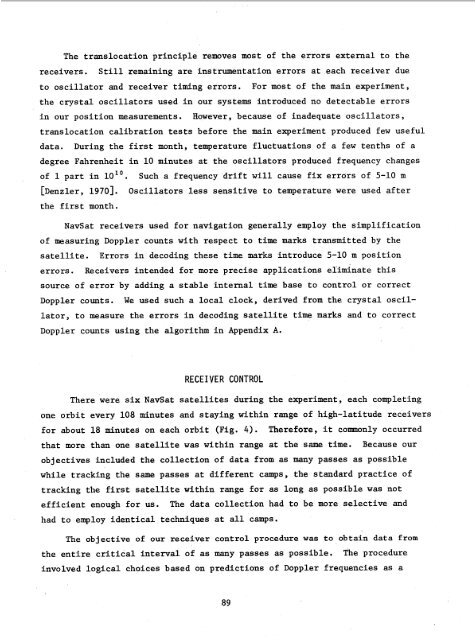AIDJEX Bulletin #40 - Polar Science Center - University of Washington
AIDJEX Bulletin #40 - Polar Science Center - University of Washington
AIDJEX Bulletin #40 - Polar Science Center - University of Washington
Create successful ePaper yourself
Turn your PDF publications into a flip-book with our unique Google optimized e-Paper software.
The translocation principle removes most <strong>of</strong> the errors external to the<br />
receivers. Still remaining are instrumentation errors at each receiver due<br />
to oscillator and receiver timing errors. For most <strong>of</strong> the main experiment,<br />
the crystal oscillators used in our systems introduced no detectable errors<br />
in our position measurements. However, because <strong>of</strong> inadequate oscillators,<br />
translocation calibration tests before the main experiment produced few useful<br />
data. During the first month, temperature fluctuations <strong>of</strong> a few tenths <strong>of</strong> a<br />
degree Fahrenheit in 10 minutes at the oscillators produced frequency changes<br />
<strong>of</strong> 1 part in lo1 O .<br />
Such a frequency drift will cause fix errors <strong>of</strong> 5-10 m<br />
[Denzler, 19701. Oscillators less sensitive to temperature were used after<br />
the first month.<br />
NavSat receivers used for navigation generally employ the simplification<br />
<strong>of</strong> measuring Doppler counts with respect to time marks transmitted by the<br />
satellite. Errors in decoding these time marks introduce 5-10 m position<br />
errors. Receivers intended for more precise applications eliminate this<br />
source <strong>of</strong> error by adding a stable internal time base to control or correct<br />
Doppler counts. We used such a local clock, derived from the crystal oscillator,<br />
to measure the errors in decoding satellite time marks and to correct<br />
Doppler counts using the algorithm in Appendix A.<br />
RECEIVER CONTROL<br />
There were six NavSat satellites during the experiment, each completing<br />
one orbit every 108 minutes and staying within range <strong>of</strong> high-latitude receivers<br />
for about 18 minutes on each orbit (Fig. 4). Therefore, it commonly occurred<br />
that more than one satellite was within range at the same time. Because our<br />
objectives included the collection <strong>of</strong> data from as many passes as possible<br />
while tracking the same passes at different camps, the standard practice <strong>of</strong><br />
tracking the first satellite within range for as long as possible was not<br />
efficient enough for us. The data collection had to be more selective and<br />
had to employ identical techniques at all camps.<br />
The objective <strong>of</strong> our receiver control procedure was to obtain data from<br />
the entire critical interval <strong>of</strong> as many passes as possible. The procedure<br />
involved logical choices based on predictions <strong>of</strong> Doppler frequencies as a<br />
89








